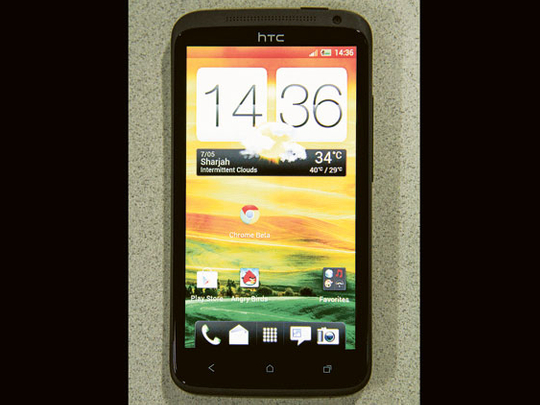
Dubai The HTC One X is a flagship product from the Taiwanese company and takes its place atop the pile as the best Android smartphone so far. The One X feels rather large but impressively slim.
The phone is very well built; the polycarbonite body shows no flex and the sides have a nicely-textured matt finish.
One of the biggest draws to the One X is its massive, 4.7-inch, 1280*720-pixel glass capacitive display. It's gorgeous, with beautiful colour, bright whites, and deep blacks. Typing on the on-screen keyboards is a breeze in both portrait and landscape mode.
The volume rocker is on the right side while the micro-Sim tray is now hewn into the unibody (you'll need a metal pin to access it at the top of the back). On the left edge there's the micro-USB port, while the headphone socket and power button are both found on the top.
The One X, priced at Dh2,499, is one of the first phones to employ a Nvidia Tegra 3 quad-core processor, clocking 1.5GHz speed, and runs on Android Ice Cream Sandwich along with HTC Sense 4, a lighter version of the company's earlier user interface overlay that doesn't mess with the built-in apps quite as much as before.
There are seven home screens you can customise and swipe between. Email conversations are threaded, and HTC's rather nice clock and weather widgets also pop up a Google Earth-style globe for tracking time and weather around the world.
Responsive
In testing, the One X felt extremely responsive, with none of the occasional stutters and hiccups I've experienced with other dual-core Android phones.
Another nice feature is car mode, which displays a beautiful landscape home screen with large icons for easy access while behind the wheel. This includes free Google Maps navigation, as well as icons for making calls, streaming internet radio, and calling up music tracks stored on the phone.
The One X is also packed with several larger-screen media-viewing options, including integrated DLNA, HDMI wireless support, and HTC's own Media Link protocol, which lets you flick photos and videos (but not games) over to a big screen.
The 8-megapixel auto-focus camera is pretty special. Test photos were sharp, detailed, and vibrant, even on a cloudy day. There's also a 1.3-megapixel front-facing camera that's useful for video chats and self portraits.
Recorded videos looked sharp and colourful right up to 1080p (1920 by 1080-pixel) resolution.
Some might baulk at the lack of a microSD slot, but 32GB of built-in storage is plenty, with 26GB of this accessible to the user, and you also get access to bonus 25GB of Dropbox storage free for two years.
Battery life, however, looks likely to pay the price for this. The One X's 1,800mAh juicepack managed six hours of continuous video playback.
I got 12-plus hours of moderate use — checking, email and social networks, making a few calls, sending some messages, taking a few pictures, downloading apps.
Pros
- Elegant design and superb screen.
- Some great camera features.
- Capture video and pictures at the same time.
- First Tegra 3 processor.
- 25GB cloud storage facility.
Cons
- Poor battery life.
- Weak internal speaker.
- Poor quality photos/videos in low light.
- Micro Sim.











